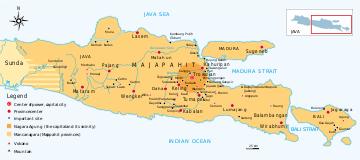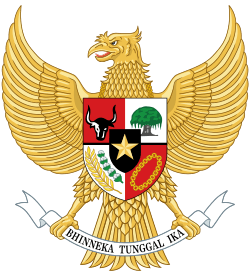Nusantara
Nusantara is a contemporary Indonesian term for the Indonesian archipelago.[1] It originated in Old Javanese and literally means "archipelago".[2] In Malay, Nusantara means the Malay world.
The word Nusantara was taken from an oath by Gajah Mada in 1336, as written in the Old Javanese Pararaton and Nagarakretagama.[3] Gajah Mada was a powerful military leader and prime minister of Majapahit who was credited with bringing the empire to its peak of glory. Gajah Mada delivered an oath called Sumpah Palapa, in which he vowed not to eat any food containing spices until he had conquered all of Nusantara under the glory of Majapahit.
Today, Indonesian historians believed that the concept of Nusantara was not an idea coined by Gajah Mada for the first time in 1336. It was coined earlier in 1275 as Cakravala Mandala Dvipantara by Kertanegara of Singhasari.[4] Dvipantara is a Sanskrit word for the "islands inbetween", the synonym to Nusantara as both dvipa and nusa mean "island". The term is used to describe the Southeast Asian Archipelago. Kertanegara envisioned the union of Southeast Asian maritime kingdoms under Singhasari as a bulwark against the rise of the expansionist Mongol Yuan dynasty in mainland China.
Ancient concepts of Nusantara


Etymology
Nusantara is a Javanese word which appears in the Pararaton manuscript. In Javanese, Nusantara means "outer islands", from nūsa, meaning "island" and antara, "within". Based on the Majapahit concept of state, the monarch had the power over three areas:
- Negara Agung, or the Grand State, the core kingdom. The traditional or initial area of Majapahit during its formation before entering the imperial phase. This includes the capital city and the surrounding areas where the king effectively exercises his government. The area in and around royal capital of Trowulan, port of Canggu and sections of Brantas River valley near the capital, also mountainous areas south and southeast of capital, all the way to Pananggungan and Arjuno-Welirang peaks, are the core realm of the kingdom. The Brantas river valley corridor, connecting Majapahit Trowulan area to Canggu and estuarine areas in Kahuripan (Sidoarjo) and Hujung Galuh port (Surabaya) are considered as parts of Negara Agung.
- Mancanegara, areas surrounding Negara Agung — traditionally refer to Majapahit provinces in East and Central Java. This area covered the eastern half of Java, with all its provinces ruled by the Bhres (dukes), the king's close relatives. These areas are directly influenced by Javanese Majapahit court culture, and obliged to pay annual tributes. These areas usually possess their own rulers that might be directly related, foster an alliance or intermarried with the Majapahit royal family. Majapahit stationed their officials and officers in these places and regulate their foreign trade activities and collect taxes, yet they enjoyed substantial internal autonomy. This includes the rest of Java island, Madura and Bali. However, in later period, overseas provinces which has developed culture reflected or comparable to those of Java, or possess significant trading importance, are also considered as mancanegara. Either the province has their own native rulers subject (vassal) to the king, or a regent appointed and sent by the king to rule the region. This realm includes Dharmasraya, Pagaruyung, Lampung and Palembang in Sumatra.
- Nusantara, areas which do not reflect Javanese culture, but are included as colonies and they had to pay annual tribute. They enjoyed substantial autonomy and internal freedom, and Majapahit did not necessarily station their officials or military officers here; however, any challenges on Majapahit oversight might draw severe response. These areas such as the vassal kingdoms and colonies in Malay peninsula, Borneo, Lesser Sunda Islands, Sulawesi and Maluku.
The first appearance of Nusantara concept in the 20th century

In 1920, Ernest Francois Eugene Douwes Dekker (1879–1950), who was also known as Setiabudi, introduced a new name for this proposed independent country (successor state of colonial Dutch East Indies) — which unlike its currently used name of "Indonesia" — did not contain any words etymologically inherited from the name of India or the Indies.[5] The new proposed name was the locally developed name Nusantara. This is the first instance of the term Nusantara appearing after it had been written into Pararaton manuscript.
The definition of Nusantara introduced by Setiabudi is different to the 14th century definition of the term. During the Majapahit era, Nusantara described vassal areas to be conquered. Setiabudi didn't want this aggressive connotation, so he defined Nusantara as all the Indonesian regions from Sabang as far as Merauke.
Modern usage
Today in Indonesian, Nusantara is synonymous with Indonesian archipelago or the national territory of Indonesia, in this sense the term Nusantara excludes Malaysia, Singapore, Brunei and the Philippines. While in Malaysian this term is synonymous and often interchangeable with Malay archipelago or Malay realm (Malay: Alam Melayu) which includes those countries.
Nusantara studies
The Nusantara Society in Moscow conducts studies on the Nusantara region's history, culture, languages and politics.
See also
- Names of Indonesia
- Nusantara Society
- History of Indonesia
- Nusantao Maritime Trading and Communication Network
- Nanyang (region)
References
- ↑ Echols, John M.; Shadily, Hassan (1989), Kamus Indonesia Inggris (An Indonesian-English Dictionary) (1st ed.), Jakarta: Gramedia, ISBN 979-403-756-7
- ↑ Friend, T. (2003). Indonesian Destinies. Harvard University Press. p. 601. ISBN 0-674-01137-6.
- ↑ Mpu, Prapañca; Robson, Stuart O. (1995). Deśawarṇana: (Nāgarakṛtāgama). KITLV. ISBN 978-90-6718-094-8.
- ↑ Wahyono Suroto Kusumoprojo (2009). Indonesia negara maritim. PT Mizan Publika. ISBN 978-979-3603-94-0.
- ↑ Vlekke, Bernard H.M. (1943), Nusantara: A History of the East Indian Archipelago (1st ed.), Netherlands: Ayer Co Pub, pp. 303–470, ISBN 978-0-405-09776-8
External links
- Wawasan Nusantara
- Wacana Nusantara
- UNESCO: Pararaton Manuscript (MEMORY OF THE WORLD REGISTER)
- Gajah Mada article
- History Nusantara
